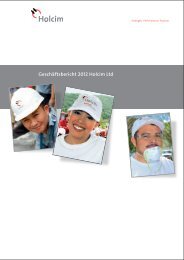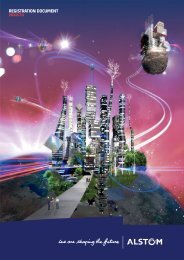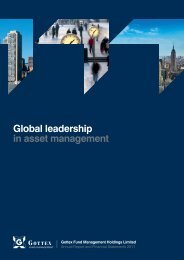Transocean Proxy Statement and 2010 Annual Report
Transocean Proxy Statement and 2010 Annual Report
Transocean Proxy Statement and 2010 Annual Report
Create successful ePaper yourself
Turn your PDF publications into a flip-book with our unique Google optimized e-Paper software.
Executive Compensation Program—Health, Welfare <strong>and</strong> Other Benefits<br />
Health Benefits<br />
We provide our Named Executive Officers with health, welfare <strong>and</strong> other benefits that we believe are<br />
reasonable <strong>and</strong> consistent with our overall compensation program. The Named Executive Officers<br />
participate in a variety of health <strong>and</strong> welfare <strong>and</strong> paid time-off benefits, as well as in the savings <strong>and</strong><br />
retirement plans described below, all of which are designed to enable us to attract <strong>and</strong> retain our<br />
workforce in a competitive marketplace. The Named Executive Officers’ medical <strong>and</strong> dental benefits for<br />
themselves <strong>and</strong> their dependents are provided through our self-funded Health Care Plan for employees on<br />
the same basis as other employees.<br />
We also provide each of our executive officers on the U.S. payroll, including the Named Executive<br />
Officers, a life insurance benefit equal to four times covered annual earnings, capped at a maximum of<br />
$1 million. Each of our executive officers may purchase at his or her own expense an additional amount of<br />
life insurance equal to one to three times his or her covered annual earnings, capped at a maximum of<br />
$500,000. The combined total of life insurance that we offer our executive officers is limited to $1,500,000.<br />
A similar level of coverage is provided to executive officers on the Swiss Franc payroll.<br />
We also provide for the continuation of base pay at the onset of illness or injury to eligible employees<br />
who are unable to perform their assigned duties due to a non-occupational personal illness or injury. Pay<br />
continuation is based on a monthly base salary, exclusive of annual incentive plan compensation or other<br />
extraordinary pay.<br />
Retirement Savings Plan<br />
Our U.S. Savings Plan is a tax-qualified defined contribution retirement savings plan in which all of<br />
our U.S. employees (citizens <strong>and</strong> tax residents), including the Named Executive Officers (other than<br />
Messrs. Rosa, Bobillier <strong>and</strong> Toma, who are not U.S. citizens or tax residents), are eligible to contribute up<br />
to 50% of their annual base salary up to the prescribed Internal Revenue Code annual limit ($16,500 in<br />
<strong>2010</strong>) on a pre-tax basis or after-tax basis (if participating in the Roth 401(k)). Subject to the limitations set<br />
forth in Sections 401(a)(17), 401(m) <strong>and</strong> 415 of the Internal Revenue Code, our Company matches in cash<br />
on a pre-tax basis 100% of the first 6% of eligible base pay that is contributed to the plan by a participating<br />
employee. Participants age 50 <strong>and</strong> older, including the Named Executive Officers who are older than 50,<br />
may also make additional ‘‘catch-up’’ contributions on a pre-tax <strong>and</strong>/or Roth after-tax basis each year, up<br />
to the prescribed Internal Revenue Code annual limit ($5,500 in <strong>2010</strong>). Catch-up contributions are not<br />
matched by the Company.<br />
Withdrawals from the U.S. Savings Plan made by an employee who is less than 59 1 ⁄2 years of age may<br />
be subject to a 10% penalty tax.<br />
Pension Equalization Plan<br />
Effective January 1, 2009, the legacy GlobalSantaFe Pension Equalization Plan <strong>and</strong> the legacy<br />
<strong>Transocean</strong> Supplemental Retirement Plan were merged into the <strong>Transocean</strong> Pension Equalization Plan<br />
(the ‘‘PEP’’), a non-qualified, non-contributory, defined-benefit plan. To the extent the annual income of<br />
an eligible employee, including the Named Executive Officers, exceeds either the annual income<br />
limitations or the annual benefit limitations imposed by the Internal Revenue Code for purposes of<br />
calculating eligible remuneration under a qualified retirement plan (income is limited to $245,000 in <strong>2010</strong><br />
<strong>and</strong> benefits are limited to $195,000 in <strong>2010</strong>), any pension benefits attributable to such difference are paid<br />
in a lump sum from general assets. The formula used to calculate benefits under the PEP is the same as<br />
that used under the U.S. Retirement Plan. The lump-sum equivalent of the accrued benefit of certain<br />
individuals as of December 31, 2008 attributable to the legacy <strong>Transocean</strong> Supplemental Retirement Plan<br />
is calculated using the interest rate in the legacy <strong>Transocean</strong> Supplemental Retirement Plan, which was the<br />
annual interest rate equal to the yield on a new 7-12 year AA-rated general obligation tax-exempt bond as<br />
determined by Merrill Lynch & Co. (or its affiliates) <strong>and</strong> published in The Wall Street Journal.<br />
P-51

















